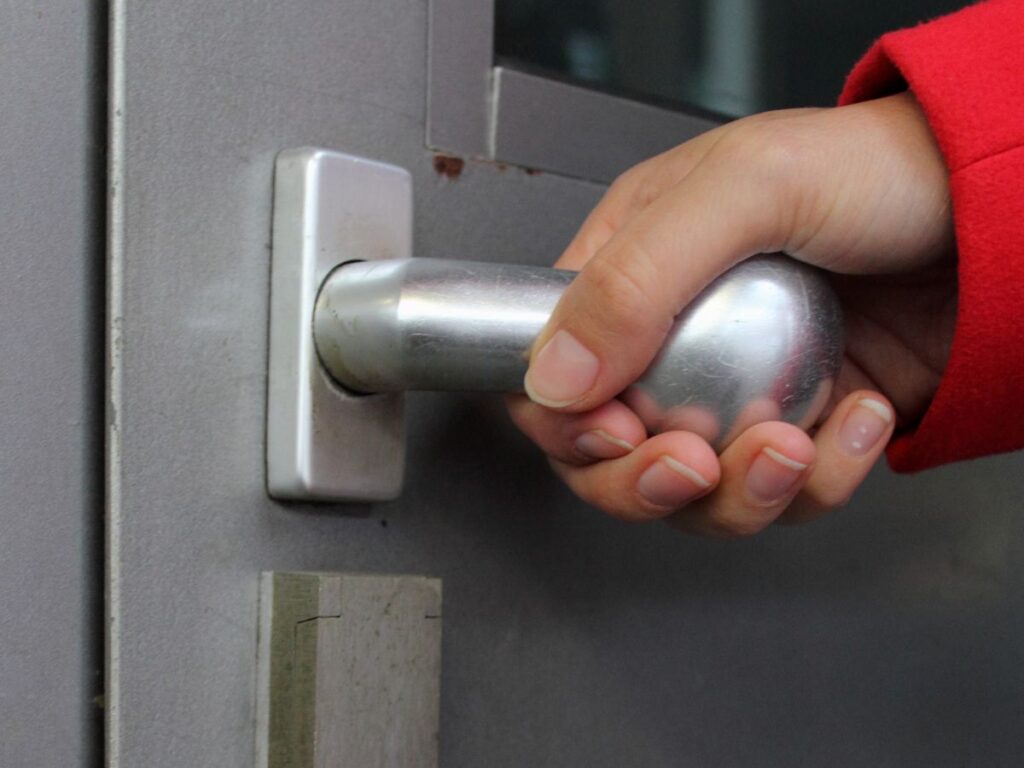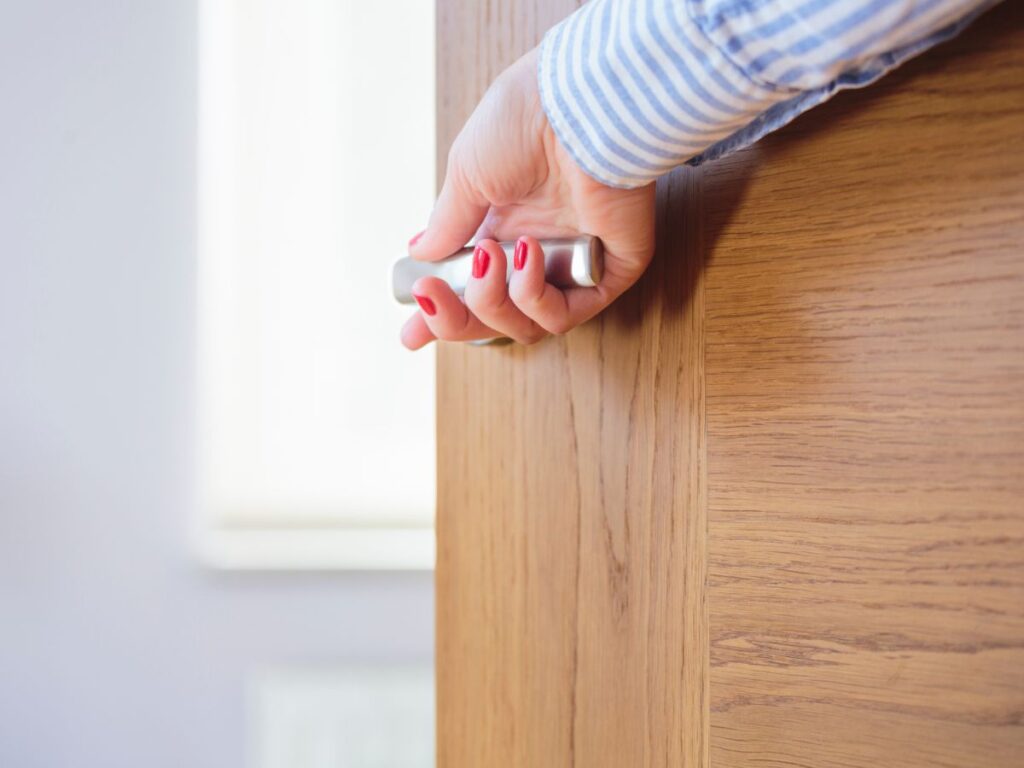A few years ago, I visited a small hotel in France to review their renovation plans. The manager complained that guests kept bumping into staff in the hallway. The cause? Several right hand swing doors were installed where left hand swings made more sense.
That experience taught me that door swing direction is more than just a detail, it shapes how people move and work.
Working with hundreds of properties, from seaside villas to boutique hotels, we’ve learned the right questions to ask before choosing a door. This review comes from that hands-on experience.
You’ll discover what a right hand swing door is, how to check for it, and when it’s the best choice. By the end, you’ll have clear answers for your project.
It’s a small change that can make your building easier to use every single day.
Let’s dive in!
1. What Does “Right Hand Swing Door” Mean?
When I visit a site, one of the first things I check is the door swing direction. It might seem small, but it affects how people move in and out of a space. A right hand swing door is simply a door with hinges on the right side when you stand on the side where you enter. If you pull it open toward you and the hinges are on your right, that’s a right hand swing.
The same rule applies if the door swings away from you. Stand where you enter, look at the hinges. If they’re on your right, you have a right hand swing door.
This simple detail can help you avoid problems later. It decides how traffic flows, how furniture is arranged, and how staff or guests move through your space. Once you know how to check, you can quickly tell if a right hand swing is the right fit for your project.
2. Importance of Door Swing Direction
I’ve seen many projects where the swing direction was an afterthought. The result? Staff bumping into each other, furniture blocking paths, and in some cases, expensive rework. Choosing the right swing from the start saves time, money, and frustration. Here’s why it matters for your property.
- Smooth Traffic Flow: The swing direction controls how people move through a space. In a busy hotel hallway or villa entry, the wrong direction can cause constant collisions and slow down movement.
- Better Space Planning: Your door should work with your layout, not against it. A door that swings into furniture or blocks access to key areas makes daily use harder than it needs to be.
- Safety and Compliance: In some regions, building codes require certain doors, like exits, to swing a specific way. Getting it right helps you stay compliant and keep people safe.
- Ease of Use for Staff and Guests: Staff carrying trays, cleaning supplies, or equipment need a swing that feels natural and doesn’t force awkward movements. Guests appreciate doors that are intuitive to open.
- Long-Term Cost Savings: Choosing the correct swing direction from the start avoids costly changes later. I’ve worked with clients who had to replace several doors just to fix a layout problem.
3. Pros & Cons of Right Hand Swing Door
I’ve worked on projects where a right hand swing door was the perfect choice and others where it caused more trouble than expected. The key is to weigh the benefits against the drawbacks for your specific layout and use. Here’s a clear look at both sides so you can make the right call for your property:
Pros of Right Hand Swing Door
- Natural Fit for Right-Handed Users: Most people are right-handed, so the handle placement on a right hand swing door often feels natural. This can make movement smoother for staff and guests, especially in high-traffic areas.
- Works Well in Certain Layouts: If your walls or fixed furniture are on the left side of the doorway, a right hand swing keeps the door from hitting obstacles. This helps you maintain a clean, open space that’s easier to navigate.
- Consistency Across a Property: Some projects benefit from having all doors swing in the same direction for uniformity. This is common in hotels or villas where consistency creates predictability for staff and reduces mistakes.
- Easy to Install in Specific Framing Situations: Depending on the frame and hinge position, right hand swings can sometimes be quicker to fit without major adjustments. This can save you installation time in certain builds.
Cons of Right Hand Swing Door
- May Interfere with Furniture or Fixtures: In some layouts, a right hand swing can block access to cabinets, shelving, or electrical switches. This means you’ll need to plan your furniture placement carefully.
- Can Cause Bottlenecks in Narrow Spaces: If your hallway or entry is tight, a door swinging the wrong way can slow down movement and create safety hazards. I’ve seen this happen in busy service areas where speed is critical.
- Not Always Suitable for Emergency Exits: Depending on your local building codes, a right hand swing might not meet requirements for certain exit doors. This is especially important in commercial or hospitality projects.
- Potential for Increased Wear in High-Traffic Use: If the swing direction forces people to push or pull against natural movement patterns, hinges and handles can wear out faster. This leads to more frequent repairs or replacements over time.

4. Common Use Cases for Right Hand Swing Doors
Over the years, I’ve noticed certain situations where a right hand swing door just makes sense. These aren’t random choices, they’re based on how the space is used, who’s using it, and what’s around the doorway. Here are the most common scenarios where I’ve seen this type of door work well:
Main Entrances in Villas and Hotels
Main entrances often benefit from right hand swings when the natural approach is from the left side. Guests can open the door smoothly with their right hand, and the swing moves toward open space instead of blocking the walkway. This can make check-in areas or front lobbies feel more welcoming and easier to navigate.
Service and Staff Access Points
In hotels, inns, and restaurants, staff need doors that work with their movement patterns. Right hand swings often fit well in areas where staff enter from a corridor with equipment or trays in their left hand. The swing direction keeps the door from colliding with walls or carts stored nearby.
Rooms With Left-Side Fixtures or Furniture
If a room’s layout places furniture, built-in cabinets, or large fixtures on the left side, a right hand swing helps avoid collisions. I’ve seen this in guest rooms, kitchens, and even greenhouse workspaces where the left side is used for storage or equipment. This setup keeps the door clear and usable without rearranging the whole room.
Hallways and Corridors With Consistent Flow
In properties where multiple doors open into the same hallway, using the same swing direction can help maintain smooth traffic flow. Right hand swings in this context keep all doors aligned, which reduces confusion for both guests and staff. It’s also easier for cleaning or maintenance teams moving quickly through the space.
Outdoor Access to Gardens or Patios
Right hand swings can be ideal for doors leading to outdoor areas when the open space is on the right. In villas or boutique hotels, this might mean a door from a bedroom to a patio or from a dining area to a garden. The swing direction keeps the path clear for serving, cleaning, or moving outdoor furniture.

5. Right Hand vs. Left Hand Swing Door: How to Tell the Difference
I’ve met many property owners and builders who weren’t sure how to tell the difference between right and left hand swing doors. It’s an easy check once you know the steps. You just need to stand in the right spot and look at where the hinges are. Here’s a simple table you can use on-site:
| Feature | Right Hand Swing Door | Left Hand Swing Door |
| Position When Checking | Stand on the side where you enter the room or building | Stand on the side where you enter the room or building |
| Hinge Location | Hinges are on your right | Hinges are on your left |
| Handle Location | Handle is on your left when facing the door | Handle is on your right when facing the door |
| Opening Toward You | Pull toward you with hinges on right | Pull toward you with hinges on left |
| Opening Away From You | Push away with hinges still on right | Push away with hinges still on left |
| Best For | Spaces with clear area on the right side or where right-handed use is more natural | Spaces with clear area on the left side or where left-handed use is more natural |
Once you know where to stand and what to look for, you can identify a door’s swing direction in seconds. This small step can save you from ordering the wrong door or running into layout problems later.
6. Mistakes to Avoid When Working with Right Hand Swing Doors
I’ve seen the same issues pop up again and again in villa projects, hotel builds, and even small commercial spaces. Most of these problems could have been avoided with a little planning. Here are the most common mistakes I warn clients about when choosing and installing right hand swing doors.
Ignoring the Room Layout
Choosing a right hand swing without checking the surrounding space can cause constant frustration. If the door opens into furniture, shelving, or equipment, it reduces usability. I’ve been on projects where owners had to move built-ins just to make the door work.
Vallisco often helps clients plan layouts early to avoid this. Always visualize the swing before placing the order. This step is simple but often skipped.
Overlooking Traffic Patterns
A door should help people move smoothly, not slow them down. If your main flow of movement is from the right, a right hand swing might create a bottleneck. This is especially true in narrow corridors or service areas.
Watch how your staff or guests naturally move before making a decision. That observation can save you from costly adjustments later.
Forgetting Building Code Requirements
In some regions, the swing direction of certain doors is regulated by law. Emergency exits, in particular, may need to swing in a specific direction. I’ve seen projects fail inspections for overlooking this detail. Always check local regulations before finalizing your order. Compliance issues are much harder to fix after installation.
Mismatching Door Swings in the Same Area
Mixing right and left swings without a plan can confuse users and slow staff. In hotels or multi-unit buildings, consistency helps avoid accidents. I’ve walked through spaces where alternating swings caused carts to crash into doors. Decide on a pattern for each section of your property and stick to it. This keeps operations running smoothly.
7. 4 Factors to Consider When Choosing Right Hand Swing Door
I’ve worked with owners and engineering teams who made the right choice the first time, and others who learned the hard way. Picking a right hand swing door isn’t just about preference. It’s about how the door will work in your space, day after day.
Here are the main factors I recommend you think through before you decide:
Space Around the Doorway
Before placing your order, check what’s on both sides of the doorway. A right hand swing works best when the area on the right is open and clear. If there’s a wall or large furniture there, the swing could feel cramped.
Walk through space with the door movement in mind. Vallisco often advises clients to map this out on-site before finalizing the design. This small test will help you spot any problems early and save you from rearranging your layout later.
Traffic Flow and User Habits
How people move through the space matters as much as the layout. Watch your staff or guests in action, do they naturally approach the door from the left or right? If most approach from the left, a right hand swing could feel awkward.
This is especially important in busy hotels, kitchens, or service areas where speed and efficiency are key. The swing direction should match the natural movement of the people using it most.
Building Code and Safety Requirements
Some projects fail inspection because they didn’t account for swing direction rules. In certain locations, exit doors must swing toward the path of escape. Ignoring this can lead to costly rework.
Always confirm the code before ordering. This applies whether you’re outfitting a single villa or an entire hotel property.
Consistency With Other Doors in the Property
If every door in a hallway swings the same way, staff and guests quickly learn what to expect. Mixing directions without reason can cause confusion and slow movement.
I’ve walked through properties where inconsistent swings made even experienced staff hesitate. Decide on a pattern early and keep it consistent for each section of your building.
Conclusion
That hotel hallway I told you about is still fresh in my mind, staff bumping into guests because of a simple swing decision.
This article gave you the tools to avoid that. You’ve seen the meaning, pros and cons, and key mistakes to watch for.
The right swing makes work smoother and spaces safer. Vallisco specializes in right hand swing doors for properties across Southeast Asia and Europe.
With the right choice, your spaces can run effortlessly. Ready to plan your project with the right door swing? Contact us today and let’s make your layout work better.
Explore Related Resources
Want to see more? We’ve gathered additional product choices to give you even more variety:
Still haven’t found what you’re looking for? Don’t hesitate to contact us. We’re available around the clock to assist you.







